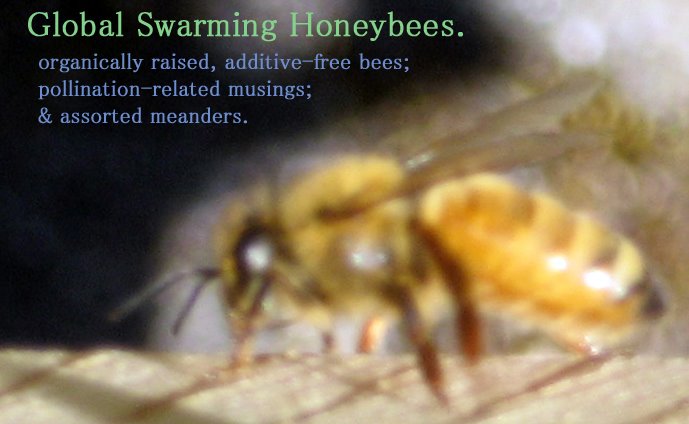During our inspection of Hive Orange today, a bit of nectar was spilled from one of the combs as we lifted it out of the hive. Right away, one of the girls came by to work on clean-up--you can see her red proboscis sipping the nectar. Also, a bit of pollen somehow ended up on here as well. This lipstick-red pollen may be coming from our horse chestnut tree, which is now in bloom, and covered with honeybees.

Here is a close-up of the horse chestnut's blossoms and pollen. Irresistible, no?
Here's the tree, which has a pretty magnificent form. The family who owned this house from the 1950s through the early 1990s planted this tree. (The story goes that they transplanted the sapling from a public park in Newburgh, NY--which, coincidentally, is where my grandmother worked in a hat factory during her youth. Perhaps she strolled beneath the shade-inducing branches of this tree's ancestors....).
To the right of the chestnut, you'll see a tiny plum tree with an old wooden box around the base of its trunk. The previous owners put the box there to protect the plum from the lawnmower. On close examination, I realized it was part of an old Langstroth beehive. The previous owner briefly experimented with beekeeping, probably in the 1980s.

5.28.2007
Nectar drop
5.25.2007
A Most Fabulous Honeybee
Click this purple bee.
Drone comb & drones
Drones are little bigger than worker bees, and the cells in which drones develop show the difference. Marked in black is some capped drone comb. Marked in blue is a drone. Drones have bigger eyes than workers (the better to spy the queen during mating flights, perhaps). Drones also lack stingers, so if you're trying to show off your beek coolness, you can pick up a drone with your bare hands.
Here's a better look. Inside the capped cells, the drone larvae are undergoing metamorphosis.
5.18.2007
Comb Inspections

By May 11 (the bees' fourth week in the hive), the size and number of the combs being built in Hive Orange and Green Hive had doubled from the previous week. We briefly removed and examined each comb in each hive to check that both queens were alive and laying eggs. The darker, burnt-orange portions of the comb are where pollen is being stored. In some of the cells above, where you see shimmery white, that's curled up larvae: bees-to-be.
Here's a closer look:
We were pleased to see evidence of a laying queen in both hives and to actually glimpse the Hive Orange queen during our inspection. 

Inside the Hive
It was impressive to see how much comb-building the bees had done in just 3 weeks. Such elegant, pristine work!
Here you see the combs built in Hive Orange. A week after these pics were taken, another 6 or 7 new combs had been built here, and Green Hive was building up comb even more quickly.
The cells in these combs are being filled with nectar, honey, pollen and eggs. The queen lays about 1,500-2,000 eggs each day; as these eggs hatch into larvae and then metamorphose into bees, they replace the elder workers who have reached the end of their short lifespan. Over time, if all goes well, the colony will grow in size from its original 3-lb. package size of about 10,000 bees to 60,000 or more. The bees will work hard to gather enough nectar to enable the colony to survive the winter, though most of the gatherers will never live to see the spring.
On the hive floor you can see crystalized sugar from our syrup-feeding, along with pollen gathered by the bees. The pollen colors are sorbet-like: soft and fiery orange, rose-red, grey, bluish-purple, and yellow. Below, at left, you can see a bee with some pinkish pollen on her hind leg, which is fitted with neat little structured called a pollen basket.
"Dangling Swamp-lover!"
Sounds like something Robin would exclaim in the last 30 seconds of a Batman episode, but actually it's a cool little fly that protects itself by looking a lot like a bee.
Just as soon as the snow stopped and the crocuses bloomed, the honeybees were on the case, working those blossoms and gathering pollen.
This critter (to right of honeybee) made an appearance, too. Athough I couldn't find it in my Audubon Society Field Guide to the Insects, a quick Google search of "honeybee mimic fly" brought me to photos of Helophilus pendulus, a type of hoverfly whose scientific name, according to wikipedia, means, "dangling swamp-lover."
One of the things I am enjoying about beekeeping is how it's opening my eyes to other insects. Everytime I see something in bloom now, I'm on the lookout for interesting pollinators, as well as for "my" honeybees. The bees are also introducing me to new botanical nuances, like the concept of nectar flow and a greater appreciation of pollen.
5.16.2007
Feeding Frenzy (Duh! Doh! Double-Doh!)
The bees were hived during a time when it was way too cold for them to fly. Even if they could fly, nothing had blossomed yet to provide the nectar flow on which they depend for sustenance.
So the bees had to be fed until conditions changed for the better. I'd started out using the allegedly foolproof "baggy method" wherein a Ziploc bag is filled partway with syrup, laid on the floor of the hive, and slit open a bit to allow the bees to perch on it and gather syrup with their proboscises—a bucolic image in a plastic-laden-21st-century sort of way.
Unfortunately, when I dumped the three-pound package of bees into the hive where I'd placed the baggy, the weight of the falling swarm caused a small tsunami of syrup to soak the Green Hive, engulfing what seemed like a thousand bees. Bees died, I cried, and lessons were painfully learned.
Lesson 1: The word "foolproof" should be banned from the English language.
Lesson 2: Even if you think you have thought through every possible outcome of a seemingly innocent action, you haven’t.
Lesson 3: Book-learnin’ doesn't hold a candle to experience.
The soaked swarm of distraught, demoralized bees was not a pretty sight. Fortunately, the death toll was much lower than it initially appeared. (I’m traumatized for life; the bees seem to have moved on). Which brings me to Lesson 4:
There’s a good reason why honeybees are considered a "superorganism."
Hive Orange, needless to say, was not subjected to the foolproof baggy method. There, I first tried a little bowl of syrup with sticks on the surface to serve as a landing pad. But the bees polished that off too quickly to keep up, and in the cold weather I did not want to keep opening the hive every three hours. (Plus, I needed some sleep after all the Ziploc-related emotional upheaval.)
I finally settled on quart-sized Mason jars, inverted, with little nail-holes in the lid (sharp side in, so the bees wouldn't be injured). The jars were set on top of a pair of squared-off chopsticks to create a nice crawl space for the bees. That's worked very well, been easy to deal with, delivered plenty of food for days at a time, and so far has not resulted in mass deaths. The bees have emptied as many as two such jars per week per hive.
Here you see a bit of comb the ever-vigilant bees started building on one of the mason jars.
5.15.2007
Setting Up

Here's Green Hive with the two packages of bees to be hived. This hive structure is called a top-bar hive. It allows for a more "natural" process for raising the bees, wherein they build their own comb in the free-spirited, catenary shapes they would create if left to their own devices (e.g., if, for example, they were nesting in a tree).
With the "standard" Langstroth hive, the bees are generally provided a manmade, framed structure (foundation) for building comb in a manner that facilitates automated honey-removal. The top-bar method doesn't necessarily bring the beek as much honey as the Langstroth method. Nor does it lend itself to mechanized honey extraction. But it lets bees be bees and is thought to aid in the reduction of varroa mite infestations due to the smaller size of the cells the bees construct on their own. (Cell size is a long story we'll get into another time.)





